#helminth parasites
Text

... Helminth ...
#helminth#parasites#stonehenge#monolith#lovecraftian#surrealhorror#desert#deathvalley#horror#surrealai
4 notes
·
View notes
Text
unique names and insults for people my beloved....
#helminth is a medical term for a worm-like parasite for the record!#i don't think Romeo would like that nickname....
0 notes
Text
More parasite research!
What are parasites?
Parasites are organisms that feed off of another organism and use them for their own gain. They give no benefit back to the host or the organism it steals from. Most times they harm their host back in surviving.
More details are present in a previous parasite page I wrote, but parasites can be classified into three types.;
Ectoparasites are external parasites that appear as bugs most times. These include fleas, bed bugs, ticks, and mites.
Helminths are worm-like parasites that almost always live in your GI tract. They are visible most times at adult size. These are flukes, tapeworms, and roundworms most times.
Protozoans are single celled organisms and will most often be internal. They aren’t visible unless you use a microscope and travel like bacteria or viruses. They are also often in the blood or flesh tissues.
What are endoparasites and their two subcategories?
An endoparasite is one that lives inside the body of its host. This would include Helminths and Protozoans, but not Ectoparasites*.
* Fun fact is that ecto means external/outside and endo means internal/inside if you need to remember through prefixes.
Most parasites are endoparasites. However, there are two further classifications:
Intercellular are helminths or the worm parasites. They inhabit the body of the host, in whichever tissue (or major bundle of cells) they find fit.
Intracellular are protozoans or the single celled parasites. They inhabit the cell(s) of the host such as red blood cells. They are incredibly small.
Examples of endoparasites:
Roundworm
Roundworms live in your intestines and can be over a foot long at adult length. They often appear pink or white with tapered off ends. Most times you will not notice symptoms unless it is a severe infestation. Their maturation process takes two to three months and they live for about two years. They only need one host.
How they travel is through your lungs, bloodstream, and intestines. They start as microscopic eggs that you swallow. The eggs travel through your stomach into your small intestine where they hatch. Once the eggs hatch and grow into larvae, they will travel to your lungs through your bloodstream or lymphatic system. They will stay inside your lungs for one to two weeks and during this time you might experience coughing or other breathing issues. After they develop into stronger larvae, they will travel to your throat where you will cough them up, then swallow them back down into your small intestines where they will stay until they die.This could give the symptoms of abdominal pain, nausea, vomiting, and diarrhea. Clusters of them might also make you have sudden weight loss, malnutrition, or actually seeing them in your stool.
Most times they will not be lethal or severe unless they are in heavy infestations. Clusters can lead to slower growth due to malnutrition, intestinal blockages or bleeding due to them blocking off the area or pressing on the area too harshly, and then covering up ducts to your pancreas or liver which will prevent them functioning.
Tapeworm:
Tapeworms live in the intestines, but in inactive states they can live in many different parts of the body such as the brain, liver, lungs, heart, or eyes. Tapeworms are a type of flatworm.There can be no symptoms or wildly varied ones depending on where they are in the body and how large the infestation is.
Tapeworms need two separate hosts to live through their entire lifespan. The first host is called the immediate host and most times these are animals such as cows, pork, and fish. The second host is the definitive host and this is often a human. There are also cases of human to human transmission.
Their life starts as microscopic eggs, sometimes on the food of animals or grass. The animal would eat them from vegetation or their food source and the eggs would travel to the intestines where they would hatch. Once they grow into a larvae, they will travel through the bloodstream into the muscles where they will form a protective shell and remain in the muscles. The animal will then often be killed and their meat will be eaten by a human. If the meat is undercooked or raw or not properly stored, the larvae (now in their larval cysts stage with their protective shell) will travel through the second/definitive host or the human’s body until they reach the intestines. Then, they will mature into an adult tapeworm and attach to the intestine walls. This is the traditional and full life of a tapeworm along with being the main reasoning behind finding tapeworms.
The other tapeworm related infection are the larval cysts. In the stage listed above, their goal is to make it to the intestines to grow into adults, but sometimes, the blood stream leads them away and they stick to other organs (listed first paragraph) where they form cysts. If the cysts burst, the tapeworms are spread further and most times they are overlooked as they are hidden within the body.
In traditional lifespans of tapeworms, where they live in the intestines, they will often not be lethal and at most cause anemia, blockages, and allergic reactions in larger quantities. If the larval cysts travel or get stuck, they cause more severe issues like damage to nerves, inflammation, excess fluid build up, and bacterial disease. This can lead to disease killing the organs.
Hookworm:
Hookworms live in the small intestines and are soil transmitted parasites. They have a hooked head, giving its name, and appear pale gray or pink. They are mainly blood feasting through the intestines. Most worms live one to 5 years with exceptional specimens living over fifteen years. Most times many worms will infect a person and most die within the first year, leaving the other worms more room to survive.
Their lifetime starts from an infected person’s intestines. When the host defecates, most times into the soil, it lets the worms escape the host’s body and the eggs are laid with the stool. From there the eggs hatch and they mature into larvae. The main way they infect other humans is by penetrating human skin when humans walk barefoot through infected soil. The other way they infect a human is through them ingesting the larvae. Either way, both end up traveling through the circulatory system to the lungs, then they are coughed up. Once they are coughed up into the mouth, they are swallowed into the stomach, then they mature in the intestines.
No symptoms will be shown if they are swallowed. If they penetrate the skin, no symptoms will be shown minus a slight rash on the foot that was penetrated. If it is a small infestation, you won’t show signs for years. If it is a larger infestation, you may develop anemia over time and gastrointestinal issues. Lack of healthy blood cells is the main issue.
Heartworm:
Heartworms are worms that are transmitted by mosquitoes and mostly affect animals, but in rare cases- humans. It affects the heart, lungs, and blood vessels of the host. They are usually a foot long at adult size and quite thin. They live about five years on average.
These worms, like tapeworms, need two hosts (the immediate and definitive). The immediate host is the mosquito that it infects, where the eggs are carried inside of it. When the mosquito bites an animal, usually dogs (can also be cats or ferrets), the larvae travel through the mosquito and land on the bite. They crawl into the open bite by the mosquito and travel through the animal’s bloodstream. It takes six to seven months for the worm to mature into an adult. The worms reproduce and lay the eggs in the bloodstream of the animal, then a mosquito will suck up their blood and carry the eggs to repeat the cycle. They try staying closer to the heart and lungs due to it being a warm, humid, and plentiful environment for them to feast. They will also stay close in the blood vessels.
When the eggs are laid, there are many and most animals will have a large range of heartworms. They are never just one worm, they will always be multiple within the animal. The average is fifteen worms, but the higher numbers range around two-hundred fifty worms (for dogs, they are the main example. Cats don’t have as high of numbers and their worms live shorter lives). This is called a “worm burden” and makes symptoms noticeable due to there never being less than five worms per host. These symptoms are mostly going to be not noticeable or some coughing. In larger cases of worms, fatigue is more present, intense coughing, and cardiovascular organs are altered for the worms. There is also caval syndrome which is when there are so many worms that the heart cannot pump properly, so the blood is backflowed. The blood cells die from lack of oxygen and you can see similar effects in cases of heart attacks.
Dogs are the most vulnerable as they need external help to get rid of them. Some cats can get rid of their heartworms just by their own immune systems and this applies to ferrets too. Humans are rarely affected, but if they are, you need external medical help as our immune systems aren’t strong enough to get rid of them. Our immune systems may detect a threat, but it only makes the area inflamed without getting rid of the worms which causes more issues.
They feed off of the blood of the host and most times will occupy the right chamber of the heart. Some stay near the lungs as well.
The information stated above is mostly for dogs, but in cases of infected humans, the worms almost never mature to adults so they die in the larval stage. The bacteria contained within these worms makes our tissues infected as well, so our immune system attacks it by swelling and inflammation. This makes blood backflow into the human heart. So instead of there being many worms for animals that cause backflow, it is because our immune systems don’t know how to deal with the bacteria left by the larvae. Due to backflow, some people cough up blood when infected.
Whipworms:
Whipworms live in the large intestine of a host. They resemble a whip with their shape and appear yellowish. They live only around a year.
Whipworms are spread through the soil and must always be ingested for them to infect a host. When an infected person defecates in soil, the eggs are spread and laid there. Then, they need to be ingested. This can be done through touching the infected ground and placing your hands in your mouth or by contaminating the produce and the produce not being prepared properly through washing or cooking.
Light infestations have no symptoms, but heavy ones have intense symptoms such as frequent bowel movements with mucus and blood or rectal prolapse. People with weak immune systems can also grow anemic due to nutrients being stolen and growth can be delayed for children. Dogs can also be infected.
Whipworms cause infections to happen in the large intestines due to them latching onto it and having their bacteria spread. This is why bleeding is common as well.
Flatworm/Flukes:
There are multiple different variations of flukes that range from affecting the intestine to the liver to blood to the urinary tract to the lungs. Some are external and others are internal as there are many variations. They are only a few inches and have sharp suckers with teeth. They need a research paper of their own.
Almost all their life cycles revolve around two hosts with the immediate host being an animal (cattle, snail, fish, reptiles, etc.), then being spread to the definitive host, usually a human. They live twenty to thirty years on average and are not trackable until their feeding organ is destroyed (example- you might not know you have liver flukes until your liver is destroyed and cannot filter toxins to keep you alive) with minimal pain.
#helminths#parasites#parasitic worms#parasitic infections#roundworms#flatworms#hookworms#tapeworms#heartworms#mad scientists#mad science#mad scientist#research#my research#documentation#animal sciences#human parasitic infections#intestines#heart#organs#worm parasites#parasite#parasitic#life cycle#be clean people#parasitic infection#endoparasites#hyperfixation#special interest#we hyperfixating
1 note
·
View note
Text
Schistosomiasis: A Comprehensive Guide to Symptoms, Prevention, and Treatment 1
IntroductionWhat is Schistosomiasis?Types of Schistosomiasis Schistosoma mansoni Schistosoma haematobium Schistosoma japonicumTransmission of SchistosomiasisLife Cycle of Schistosoma ParasitesSymptoms and Complications of SchistosomiasisRisk FactorsDiagnosis of SchistosomiasisTreatment of SchistosomiasisGeographic DistributionPrevention and Control MeasuresPublic Health EffortsThe Impact of…
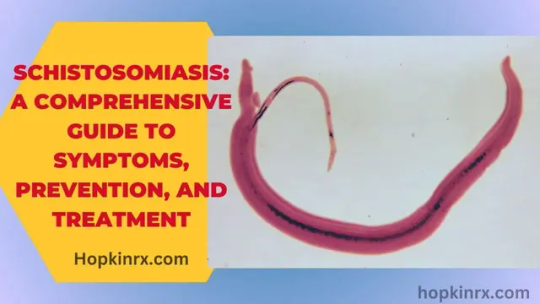
View On WordPress
#acute schistosomiasis#Bilharzia#Blood-flukes#Cercariae#disease caused by a parasite#Helminth infection#human schistosomiasis#Intestinal schistosomiasis#is schistosomiasis diagnosed#Liver fluke#Miracidium#Parasitic infection#prevention and control of schistosomiasis pdf#Schistosoma haematobium#Schistosoma japonicum#Schistosoma mansoni#Schistosome control#Schistosome eggs#Schistosome life cycle#Schistosome pathology#Schistosome species#Schistosome transmission#Schistosome treatment#Schistosomiasis#schistosomiasis also known#Schistosomiasis prevention#schistosomiasis treatment and prevention#Snail-borne infection#the symptoms of schistosomiasis#Trematode infection
0 notes
Text
A crispy & simple Anti-Parasite Probiotic pumpkin seed coleslaw that is rich with probiotics and bursting with fibre. This salad will support and boost the health of your microbiome and is perfect when treating Parasite Infections.
#guthealth#gutparasites#parasites#parasitecleanse#Protozoa#Helminths#Giardiasis#functionalmedicine#functionaltesting#foodallergies#IBS#parasitetesting#intestinalworms#herbalmedicine#Hookworm#leakygut#foodintolerance#bloating#indigestion#glutenfree#nutrition#healthyfood#wholefoods#healthy#dairyfree#probiotics#plantbased#cleaneating#foodismedicine#gastro
1 note
·
View note
Note
oh worm... 🪱

Worms are many different distantly related bilateral animals that typically have a long cylindrical tube-like body, no limbs, and usually no eyes.
Worms vary in size from microscopic to over 1 metre (3.3 ft) in length for marine polychaete worms (bristle worms) 6.7 metres (22 ft) for the African giant earthworm, Microchaetus rappi and 58 metres (190 ft) for the marine nemertean worm (bootlace worm), Lineus longissimus. Various types of worm occupy a small variety of parasitic niches, living inside the bodies of other animals. Free-living worm species do not live on land but instead live in marine or freshwater environments or underground by burrowing.
In biology, "worm" refers to an obsolete taxon, Vermes, used by Carolus Linnaeus and Jean-Baptiste Lamarck for all non-arthropod invertebrate animals, now seen to be paraphyletic. The name stems from the Old English word wyrm. Most animals called "worms" are invertebrates, but the term is also used for the amphibian caecilians and the slowworm Anguis, a legless burrowing lizard. Invertebrate animals commonly called "worms" include annelids, nematodes, flatworms, nemerteans, chaetognaths, priapulids, and insect larvae such as grubs and maggots.
The term "helminth" is sometimes used to refer to parasitic worms. The term is more commonly used in medicine, and usually refers to roundworms and tapeworms.
8 notes
·
View notes
Text
Jade Shadows spoilers but spinning ideas for my Viriverse
Jade in Nidus' colors.
Stalker arrived at the Orbiter but instead of the Operator he found Voland and Umbra who were ready to kill him but Stalker actually decided to Tell His Story and Voland was all "By the Stars, bring her here STAT" and Stalker was all "I can't" so Voland went with him back to Uranus, used parasitic link on Jade and they transported her to Artemis' Orbiter where Voland used Helminth infusions on Jade to heal her.
She regains her strength and is no longer in mortal peril. She gives birth to the Warframe baby and doesn't die and is no longer pregnant.
There, happy ending that I am satisfied with. Stalker and Jade and their baby return to Uranus and live happily ever after.
Artemis returns and Voland and Umbra tell her about the Warframe Birth and she is just all "you GOTTA be shitting me".
Artemis, Iris, Virgo and Eir go do ascension missions and when Green Stalker appears they all collectively shit their pants (metaphorically).
Voland promised Stalker and Jade he would not make a Huge Deal out of this ordeal so the couple can live in peace, but once Parvos appears and tries to steal Jade's light powers, the two are forced to act. That's how they team up with the Virisquad.
8 notes
·
View notes
Text
Knives: Obtained
In my previous post I shared my excitement about finally getting a Helminth invigoration for ability strength to unbind and apply to my Baruuk in pursuit of acquiring as many knives as humanly possible. I mentioned in the previous post that I was hoping I could reach 200 knives. However, I was joking when I said that. I didn’t think that was really attainable, and expected to see somewhere between 120-140 knives at best.
It turns out I had set my sights far too low.

By the time all was said and done, my pacifist was running around the stage with 644 knives.

My brother, who had joined the squad to help with this endeavor, described it as both a “hula hoop” and the “rings of Saturn”, both of which are wholly accurate descriptions.

My Shade, on its own, had more than double the knives I originally thought it was even possible to obtain by the end of the mission.
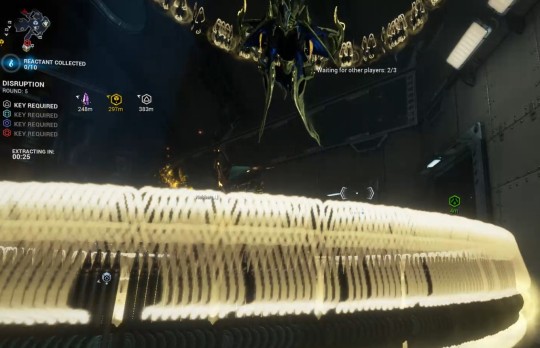
In case anyone is interested, here is the math for it all:
Baruuk ability strength (mods + archon shards): 428%
Helminth invigoration: 200%
Growing power + 8 drain Coaction drift: 28%
Empower: 50%
Zenurik Hardened Wellspring: 20%
Equinox Peaceful Provocation: 80%
Similarly strength-buffed Nidus Parasitic Link: 313%
Madurai chained sling: 40%
Molt augmented at full buff: 60%
Molt vigor: 45%
Power Donation x2: 60%
Total before void corruption: 1,324% ability strength
Total with void corruption: 2,648% ability strength
There are some things we could have done to squeeze out just a little more ability strength. A fourth squad member running Power Donation, a couple more tau-forged crimson archon shards to replace the basic crimson shards, and Energy Conversion on Baruuk, for example. If I ever feel possessed to do this again, I have a whole list of things to do differently. But I think I’ll be riding the high of having nearly 650 knives for a long time.
68 notes
·
View notes
Text

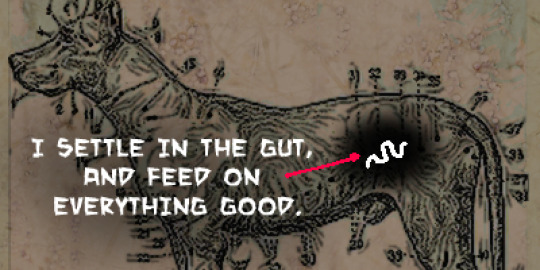
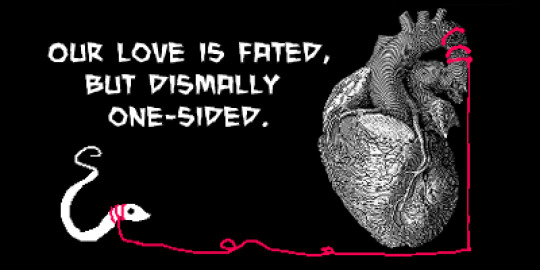

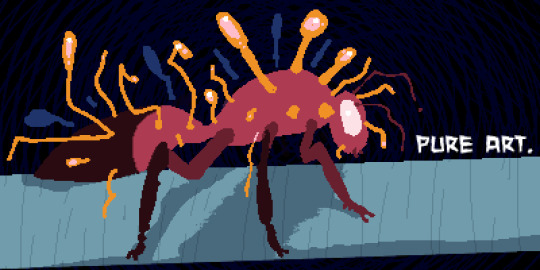





Helminthic Love.
I don't really relate to these feelings anymore, but parasites will always remain special to me because there is a version of me that did.
29 notes
·
View notes
Text
zed has proven to be a greater, wiser ally than i could have ever anticipated. they have opened my mind to new possibilities of the Machine God's lessons for me- explanations following:
there is a being within Helminth, infiltrating my very self. It is laughing at me. It is perhaps my psyche's grand representation of my greatest fight: battling the stupidity of internet trolls. or it is a demon or it is an NHP. Unclear if I am losing my mind. was freaking out as the being responded to me in the new desktop setup in Helminth. Went chasing down this presence, trying to determine exactly what it was. it eluded me, but i found the original shell it hatched from: the piece of tech I was drawn to in old ibara.
I pulled the shell out of Helminth, this parasite infiltrating my perfect vessel, but it was hollow. Whatever was within, whether NHP, manifestation of my personal demons, literal demon, or just an impossibly skilled hacker trolling me, slithers within my mechanical veins. It is also disturbingly smiley.
There was a sensation of someone standing behind me, despite no one being there, and then laughter in my head. Then:

infinite metal. falling, forever, in my brain. what reason could the Machine God have for doing this to me? I thought it must be a divine punishment. I did something wrong. Reparations must be made.
then zed said maybe there was a lesson to be learned. that the Machine God was trying to tell me something. instead of shutting out the metal pipe, maybe i should listen to it carefully. i sat and thought on the sound, and found myself in a vast dark plane, floating above an endless lake. The parasite approached me then. i still don't know what it wants.
the Machine God continues to test me... the greater the challenges, the more faith it has in me. i will continue to listen to the sound of pipes falling. i will be trolled, and i will learn from it. this is my greatest challenge yet.
#if you respond to this. i will not respond. as zed told me to#zed has great untapped wisdom#they are still so dumb#but maybe there are some things they are useful for
3 notes
·
View notes
Text
A Helminthic Romance
Short story about a girl who falls in love with her intestinal parasite, told through entries in the narrator's journal.
[Posting these in short installments in conjunction with the the dates of the journal entries.]
Read on Ao3
May 13
I felt it move inside me this morning.
I was warned of the symptoms. That is, I warned myself with some conscientious online research. Some discomfort is to be expected. Abdominal pain, nausea, vomiting, dizziness, insomnia, malnutrition - I know what I’m getting into. I took the pill in March and anticipated I’d start feeling the effects by now, but I hadn’t expected to feel it move.
I was standing at the coffee pot, measuring grounds into the filter. I only drink it black now, which kind of sucks, but there are fewer steps to making it at least. But I wasn’t doing anything especially exciting, and it chose that moment to stir in my gut.
I’m not sure how to describe it. It lurched, but it’s not big enough to lurch. It squirmed, but it’s not yet long enough to squirm. It just… moved. Like how a human infant will turn its head and stare at movement that fascinates it, uncomprehending but its attention held. That’s what it felt like. I’d done something to catch the worm’s attention, and it raised its head, as much as it was able to, somewhere unseen in my digestive tract. Just a small movement, observing but uncomprehending.
Much like you can’t give caffeine to a baby, I wondered if I could, in good conscience, give caffeine to a newly born tapeworm. What would that do to it? I don’t want to do anything to hurt it - not this early in its development. I mean, I took it for a reason, and if I killed it before it did its job, or damaged its ability to do its job, then that would kind of defeat the whole point of this experiment.
I got the pill online. It was surprisingly cheap - only 35 dollars. The seller informed me that the egg would hatch inside me and it would take a few months for the tapeworm to reach maturity. As it grew, it would eat everything I ate, growing in size until it was no longer sustainable for it to live inside me. The pill came in a set of two - one to birth the worm and the other to kill it. I’m supposed to take the second pill once I’ve either reached an acceptable weight or the tapeworm becomes too uncomfortable to live with, whichever comes first.
I’ve thought about naming it, now that I can feel it, but I think that’ll only make it harder to kill once I’ve reached my weight goal. I ended up drinking the coffee. People put coffee grounds in their compost bins and it doesn’t kill their worms, so this shouldn’t be any different.
But I mostly just wanted to stop drinking it black. I took some of Gina’s french vanilla creamer. Who knows, maybe the worm will like it. I know I did.
#ink#tapeworm story#lets see if i keep this up lol#disordered eating#self harm#body horror#parasitism
38 notes
·
View notes
Text
Warframes from the Void
Rasputin, the Occultist Warframe. Former apprentice to Archimedean sorcerers, Rasputin exposed himself recklessly to the metamorphic horrors of The Void and the technocyte flesh-virus in an attempt to gain immortality. He may have succeeded, but at a cost too great to imagine. Men cannot defy death, but monsters can. Steeped in occult energies Rasputin brandishes the elements in horrific new ways to castigate the enemies of the Tenno, exploiting weaknesses no other warframe can detect for even deadlier results with scalding, freezing, shocking, and intoxicating effects.
Zahhak, the Host of the Murmur Warframe (based on submissions made by @dapperkobold and @infestedslime). One of the Entrati families void-explorers, the warframe Zahhak delved into the twisting lands of Indifference on missions of discovery. Zahhak was lucky to return time and time again, but the Murmur only had to be lucky once. When the Entrati warframe fell the Murmur descended upon him, parasitizing his voidtouched body, absorbing and assimilating until one was no longer distinguishable from the other. A unique hybrid, the new Zahhak wanders the Indifference bristling with the arms of the Murmur, turning the parasites that fed on him into extensions of his own body.
Gangcheol, the Dax Guard Warframe. In service of the seven emperors Dax Gangcheol earned the nickname 'The Jade Dragon.' When at last he lay defeated and dying at the outbreak of the Old War he was approached on his deathbed by Executor Ballas. Gangcheol was offered a great reward for his lifelong service and unparalleled devotion; an elixir of immortality - but not the precious kuva of the Orokin, a different elixir, a poison... the Helminth seed. By the dark blessing of the Executor The Jade Dragon Gangcheol lives again. Now warframe, Gangcheol leaps into battle with speed like lightning and strength like thunder. Bring the ways of the Dax back to life with the Jade Dragon, last guardian of the empire, Gangcheol.
Vesuvius, the Volcano Warframe. The earth itself has a temper. From its high-up mouths it screams fire and brimstone, turning skies black with mother nature's castigation. The scion of her sacred wrath, Vesuvius channels the fire of Gaia's fury into his body of stone and steel. Behold his righteous fury, for he is avatar of the mountain. Vesuvius floods whole battlefields with burning wrath, calling up molten stone from the depths to simultaneously attack and defend. Enemies dare not tread in his wake, dare not climb his tower for the caldera of his anger burns even bones to ash. Become the living mountain, Tenno, harness the power of Gaia with Vesuvius the unforgiving.
Kodiak, the Bear Warframe. Legends say whole worlds shake when the ancient beast of Unairu wakes from his slumber: Kodiak, spirit of the north! Kodiak is an indomitable force, protecting and rallying his allies while foes tremble at his awesome and beastly visage. He has no fear for even in his moments of peril Kodiak can close his eyes and enter a sleep that brings him closer to the void to revitalize himself. Awakening renewed, the beast strikes once more and the cycle of life and death continue in bloody spectacle as nature intended.
9 notes
·
View notes
Text
oh no mun made herself sad with that hc
Yuri calling Romeo a helminth
a parasitic spineless worm
because Romeo left Yuri for Taiga
and Yuri is not about to explain that
9 notes
·
View notes
Text
Little thing on parasites for my hyperfixation
(INFO GATHERED FROM CDC WEBSITE)
What is a parasite?
Any organism that feeds off of another (different species usually) in order to survive. This can be both internal and external, but most are internal. The host, or species the parasite is benefiting off of or harming, never benefits from this and can be damaged from being the victim of the parasite. In this form, we are mostly talking about their effect on humans, so humans are always the host in the examples below unless specified.
What are the main sub-classes?
Protozoa
Traits- microscopic, single celled, able to multiply in humans, often transferred through a fecal-oral route or contaminated water. Some travel through insects such as mosquitoes as well for one's that are inside blood and tissue. They can live on their own or be parasitic.
Infectious subclasses- sarcodina, mastigophora, ciliophora, sporozoa
Helminths
Traits- large, multi celled, most times visible in their adult stages, and cannot multiply in humans. They can live on their own or be parasitic.
Worm subclasses- Flatworms, thorny head worms, roundworms
Ectoparasites
Traits- can be visible most times, living organisms like insects, mostly relate to human skin (burying or attachment), and very broad class. This includes arthropods. They can either just be parasitic in nature or can carry diseases with them such as malaria or lyme disease.
Specific species- ticks, fleas, lice, mites, and mosquitoes (but those aren’t officially recognized as much)
Parasitic infections
So, these aren’t really parasites, but they are classified as a subtype because they are diseases often spread by parasites (most often ectoparasites). They are less parasites on their own and more often results of being the host to a parasite or the disease that is more likely to kill you than the parasite itself. More of a symptom than the actual cause, but still deadly in its own right and needs to be taken into account.
Examples- malaria, head lice, toxoplasmosis, trichomoniasis, etc.
#mad science#mad scientist#sciencecore#parasite#parasitic#im hyperfixating again#we hyperfixating#hyperfixation#tw parasites#tw disease#healthcare#parasitic infections#organisms#science#biology#worms#parasites#infectiousness
33 notes
·
View notes
Text
definitely a parasite when it comes to pred/prey dynamics bc i will gladly play the prey role until the pred actually catches me n then i get to devour them. babygirl i am going to be doing some helminth shit to you
#nsft#oh nooo i'm so scared i'm being chased! i've tripped and broken my ankle! and now the scary pred is going to get me! oh nooo#[smiling as my new host rapidly approaches totally unaware]
4 notes
·
View notes
Text
saw someone quote some bad economics/AI doomerposting about how tech companies are bad because they're parasites and I have other complaints about everything they say but it also features this claim
Recall that only ten percent of animal species are parasites. What happens if that number grows to 30% or 50% or 70%? That must have catastrophic consequences, no?
which, man, come on, anyone who knows about parasites knows this number is bullshit. Esimates say there are at least 100k different species of helminth worm alone, probably way more, let alone parasitic wasps, flies, snails, and more. Error bars are wide but most estimates of species of animal life come in under 10 million. Hell there's over 50 thousand known parasitoid wasps. You don't have to make claims that are wrong! Even if you're counting individuals, The average zebra or salmon contains multiple parasitic worms. Battery chickens! By biomass, maybe.
5 notes
·
View notes